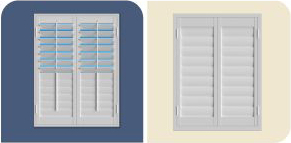How Window Shutters Help You Control Room Temperature
Closed shutters are the next best defence against the extreme temperature and wind in Minneapolis, coming right after windows. Other window treatments such as blinds, draperies, and shades block most of the temperature from the outdoors, not all. And, where a sturdy window treatment means the difference between a comfortable spot next to the window and one that’s not, Polywood® shutters are the optimal product.
Polywood shutters are made from a synthetic polymer that insulates up to 70% better than a similar traditional wood shutter. As a matter of fact, the Polywood Shutter Insulating System blocks up to 30 degrees of airflow and lessens heat transfer by 45.96%. This means energy savings for your home – and complete control over room temperature.
The heating and cooling system in your house won’t have to work so hard since you’ve now reduced the impact from the weather outside. When you want to bring in some of the light and be more exposed to the outside temperature, just tilt the louvers and adjust them to how you’d like them. Get more window treatment temperature control. All you have to do is close your shutters all the way.
How to Close Your Shutters for Maximum Temperature Control
There are two parts of your shutters that should be closed to seal off outside temperature: the panels and the louvers.
To properly close your Polywood shutter panels, swing them toward the window. As you push the panels into the shutter frame, ensure that the pieces of weatherstripping interlock along the vertical ends of your shutters.

To properly close your louvers, push the tilt rod toward the louvers and ensure that the top of the tilt rod will fit into the "mouse hole," which is above the top louver. Do this by running your hand up the tilt rod, pushing in as you go. This is also true for taller shutters. Sometimes a soft push at the bottom of the tilt rod isn't enough and doesn’t close gaps at the top.



